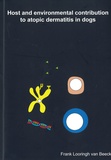Host and environmental contribution to atopic dermatitis in dogs
Summary
The research presented in this thesis is focussed on atopic dermatitis in dogs. Atopic dermatitis is a genetically predisposed, inflammatory and pruritic allergic skin disease with characteristic clinical features associated with IgE antibodies most commonly directed against environmental allergens. In this thesis we characterize the complete dog (Canis lupus familiaris) CD1 locus which is located on chromosome 38. The canine locus contains eight CD1A genes (canCD1A), of which five are pseudogenes, one canCD1B, one canCD1C, one canCD1D, and one canCD1E gene. We show differential transcription of the three canCD1A genes in skin. Based on protein modeling and protein sequence alignment, we predict that both canine CD1a proteins can bind different glycolipids in their groove. The canine CD1D gene was characterized, it lacks a sequence homologous to exon 2 of human CD1D, coding for the start codon and signal peptide. Also, the canine CD1D gene contains three different short tandem repeats that disrupt the expected gene structure. Because canine CD1D cDNA lacks sequences homologous to human exon 2 and 3, the functionality of canine CD1d protein may be affected and this could have consequences for the development and activation of canine NKT cells. Characterization of the CD1d/NKT system in mammalian species including dog is described in the thesis. In contrast to the canine CD1D gene structure and the mutated start-codon in the CD1D gene of several ruminant species, intact CD1d transcripts were found in guinea pig, African elephant, horse, rabbit, and pig. Despite the discovery of a highly homologous NKT/CD1d system in pig and horse, our data suggest that functional CD1D and CD1d-restricted NKT cells are not universally present in mammals. A study pilot showed that keratinocytes cultured from lesional sites have a reduced filaggrin production compared to keratinocytes from non-lesional sites, but it is not clear whether this is caused by an intrinsic factor or regulated by cytokines. Our findings seem to suggest that local skin conditions affect filaggrin expression of keratinocytes. In addition, we found that after stimulation with Th1 or Th2 type cytokines, keratinocytes from atopic dogs upregulate IL-8 expression, which may contribute to the influx of inflammatory cells in atopic skin during acute and chronic inflammation The development of atopic dermatitis in dogs may be related to exposure to mite allergens, bacterial endotoxin and/or fungal glucans. In a case-control study described in this thesis, indoor exposure levels of house dust mite allergens, endotoxins and fungal glucans were measured to determine their possible association with canine atopic dermatitis. The results of the study indicated that endotoxin exposure is inversely associated with canine atopic dermatitis, suggesting a protective effect of high indoor endotoxin exposure towards the development of the condition.
